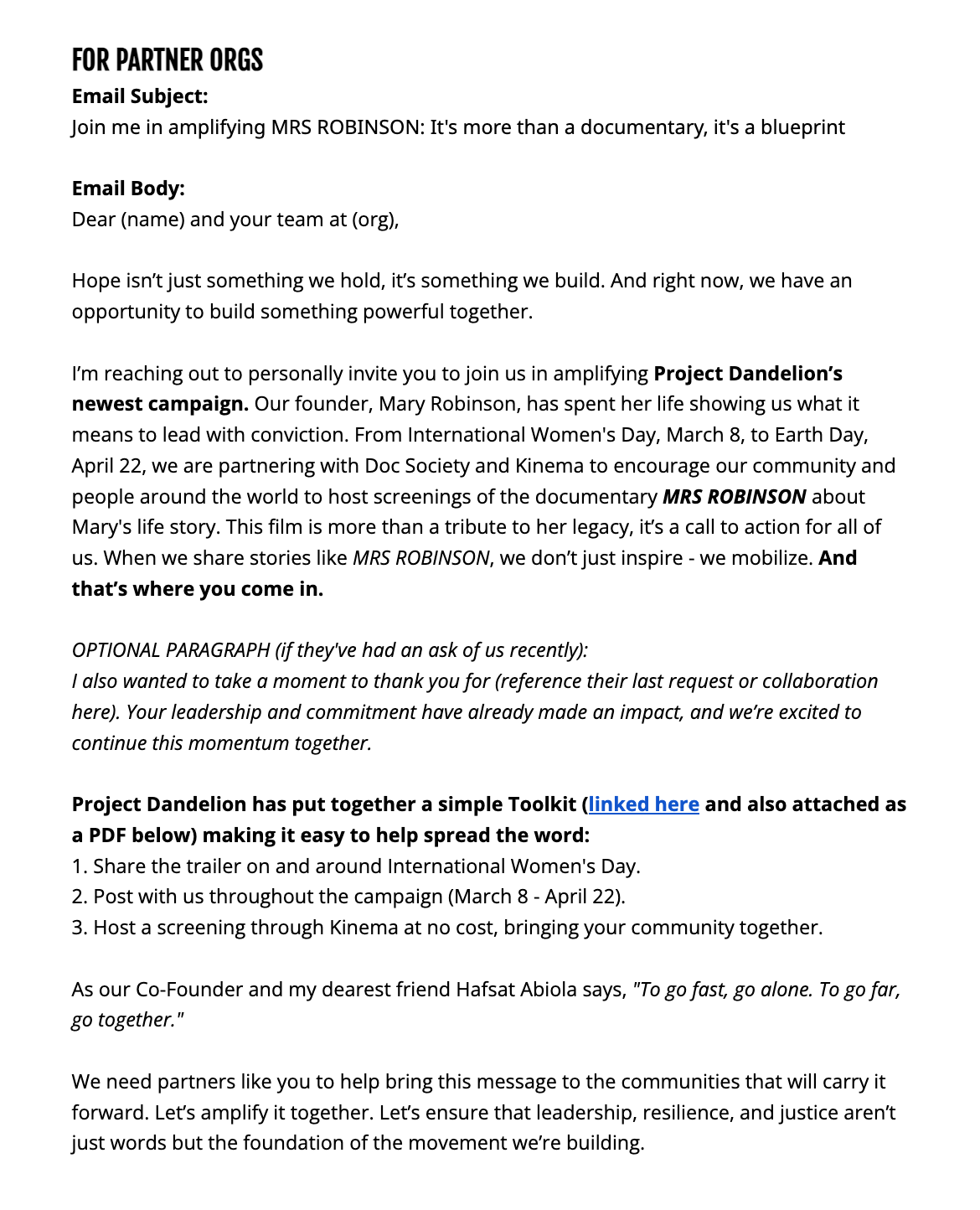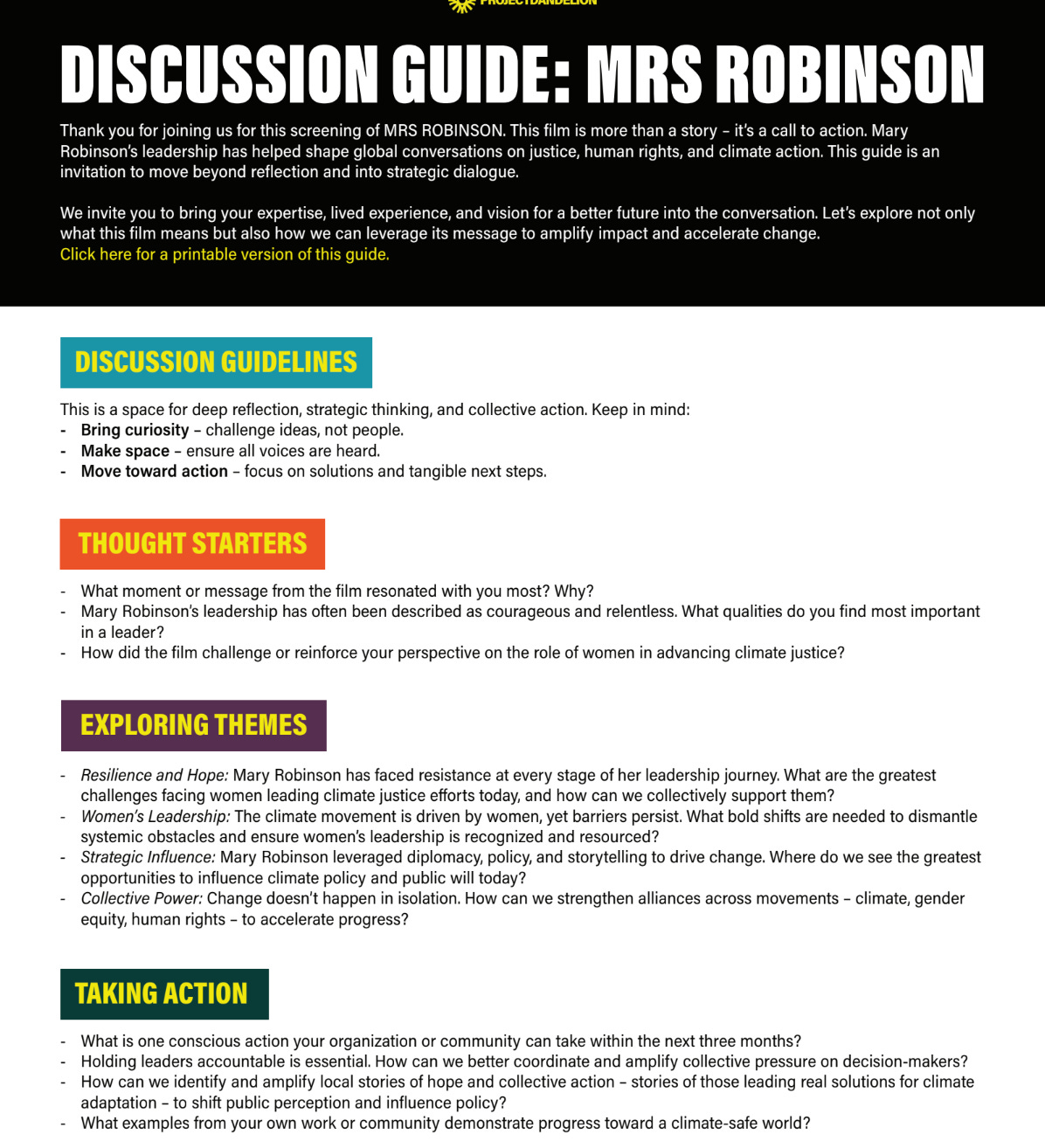100+ Partner Screenings in Under Two Months
The Project Dandelion team shares the "Mrs. Robinson" campaign, six of the resources they created, and the strategies that led to their success.
Following its world premiere at the Galway Film Fleadh, Mrs. Robinson was released in Ireland in late August 2024 and finished the year as the best-performing documentary at the Irish box office. The film chronicles the remarkable journey of Ireland's groundbreaking first female President, Mary Robinson, who later became the UN High Commissioner for Human Rights and has become one of the leading global human rights activists in the world.
Now in 2025, this documentary is expanding beyond Ireland, with one key part of that effort being an ambitious impact campaign run by Project Dandelion and supported by Doc Society’s Global Climate Playlist initiative.
The Project Dandelion team had three months to prepare a strategy and execute an impact campaign with the planned launch date of March 8, International Women’s Day. It’s been a month since that launch and more than 100 partners (including organizations and individuals) have already hosted Mrs. Robinson screening events.
I sat down with Emily Moody, Director of Operations at Project Dandelion, to learn how they built this successful campaign. Here's exactly what worked for them—and what you can apply to your own film campaign.
The Strategy: Coordinated and Consistent Messaging
Their goal was to maximize viewership among audiences most likely to take meaningful action after watching the film. By focusing on women leaders—Project Dandelion's core audience—they could tap into an established global network of thousands of change-makers already committed to securing a climate-safe future for all. The team strategically timed their campaign between two significant dates and built momentum within the community.
“The screenings run from March 8, International Women's Day, to April 22, Earth Day. We aimed to reach people that would be inspired and motivated to act by the film, which for us is women leaders.”
The Plan: Right Channels, Right Ask
With a short runway and a limited budget, Project Dandelion needed to be smart about how they developed the campaign, who they targeted, and how they made the ask.
How:
They focused the majority of their activity on social and community newsletters.
Project Dandelion identified three audiences for outreach:
Existing organizational partners (300 warm contacts)
Newsletter subscribers (5,000 individuals)
Climate content creators (50 individuals)
The team developed a unique and bold campaign that included:
A 0:60 second trailer in several formats to be used across social platforms.
Smart and simple social assets, including static images and a GIF, to give options to post and share.
An easy-to-use campaign toolkit.
What:
Distribution constraints for Mrs. Robinson meant Project Dandelion couldn’t compete with existing agreements. Free community screenings emerged as a strong path forward. They were able to use a grant from Doc Society to fund this effort.
After evaluating several platforms, Project Dandelion chose Kinema for the platform’s flexibility. Their key needs included:
Independent, host-led screenings
Email collection
Geographic data
Global accessibility
Film security
The specific ask varied by recipient and channel:
"We thought about the spaces our target audiences occupy, and tailored our approach accordingly. If they are a high network individual, then we pitched from that angle. If they're the head of an organization, we suggested hosting a screening for their team, etc. etc."
The Supporting Resources:
Project Dandelion has shared six of their templates below:
(pdf) — Amplification toolkit: shared with partner organizations and the broader Project Dandelion network to support promotion across social channels. It provides simple directions and recommended post language making it easy for their community to participate.
(doc) — Outreach templates: language-specific email formats to 7 different audiences, including: Email funders, Email creators, Email universities, Email partner orgs, Social DM warm, Social DM cold, WhatApp messaging. These tailor-made messages significantly boosted engagement.
(pdf) — Host guide: created for partners to understand how to host screenings. Initially an eight-page document, distilled into a one-page guide to streamline the hosting process:
“The entire time I was creating the hosting guide, my point of view was: if my mom was to host a screening, what questions would she ask me? I tried to answer those ahead of time.”
Emily added:
“The first iteration was like eight pages long. I fully designed it because I thought this is answering every single question that somebody might have. But ultimately, what we decided was, even if people want more information, they're probably not going to read it. So keep it simple. It took a lot of time and effort to get it to that one page.”
(canva file) — Invitation template: ready-to-use promotional asset that hosts could personalize and share.
(pdf) — Discussion guide: flexible guide for post-screening conversations, designed to support both first-time facilitators and seasoned moderators.
(mp4) — Pre-screening message: two-minute video from Mary Robinson herself, sent to hosts when they scheduled a screening. The video helped inspire audiences and reduced personal appearance requests.
The Outreach: Personalization at Scale
With materials ready, the team launched a three-tiered outreach strategy with one key principle: personalize, personalize, personalize.
1. Direct emails to partner organizations (highest conversion)
Emily and team spent an entire day sending 300 personalized emails directly from Project Dandelion’s founder's inbox:
“We always leave space in the email draft for customization, a line at the top, one in the middle, and one at the end. It takes time, but it really makes people feel like the email was written just for them.”
A key tactic was giving partners early access:
“About two weeks before International Women’s Day, we invited key partners to launch with us and offered them the exclusive chance to host one of the first screenings.”
This approach has thus far yielded approximately a 20% conversion rate, with over 60 partner organizations actively hosting screenings.
2. Newsletter(s)
The team also sent announcements to their 5,000-person newsletter list. ‘The Dandelion Digest’ serves as a go-to resource for climate updates, announcements, and a call-to-action for Project Dandelion’s engaged community. With a 50%+ read rate there was guaranteed visibility for the Mrs. Robinson campaign announcement.
Project Dandelion also asked partners to include the Mrs. Robinson announcement in their newsletters, reaching audiences that otherwise would not have heard about the campaign.
3. Climate creators
The team contacted 50 climate and human-rights-focused content creators via social media. Over 50% responded or engaged in some way: via collaborative post, a story highlight, or even hosting a screening for their community.
“We also sent messages to climate activists and content creators that we're connected with, follow, or support on social media around gender, climate, and human rights, since those are some prevalent themes in Mrs. Robinson. We got about 25 to 30 people who engaged with us with that strategy.”
4. Follow-ups
After signup, the team focused on building relationships and providing support:
"I've had several 10-minute Zoom calls with people who just want to put a face to the request that they're receiving."
Emily noted two key moments where hosts needed the most support:
Within 24 hours of receiving the initial invitation
In the 24 hours leading up to their event
Even with strong materials, some hosts simply needed reassurance:
“Some people just want a hand to hold through the process, so it’s important to plan for that time commitment.”
Top Takeaways:
Personalize your communication: “That extra layer of intention makes people feel more seen.”
Keep materials simple: “Even if people want more info, they're probably not going to read it.”
Leverage warm networks: “If you already have a connection, they’re more likely to say yes.”
Be ready to guide people through: “For new contacts, it takes more effort to get them to the finish line.”
Tap into influencers when possible: “Having well-known individuals amplify your message can make a big difference.”
Translate for global reach: “We translated emails into the most common language for each country, with English and local language side by side. That extra care goes a long way.” (Pro tip: ChatGPT is great for this.)
"Mrs. Robinson" is available for partner screenings and is free to host through April 22, 2025. Made possible through a grant from Doc Society.
Learn more about how Kinema enables filmmakers to control how their films are screened (and streamed).








Thanks so much for this Ami! It is going to be part of my playbook for sure!
Great post!